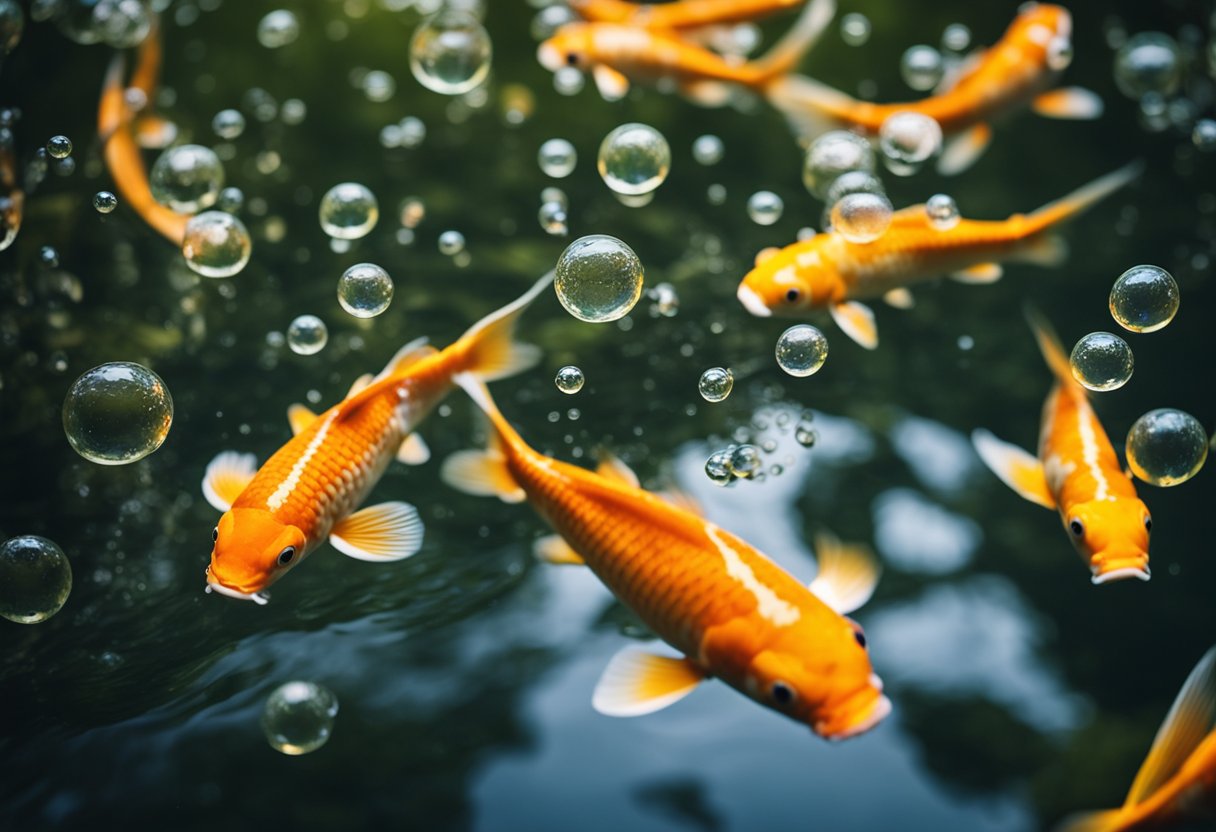Koi fish are a popular ornamental fish that are often kept in outdoor ponds. These fish are known for their bright colors and unique patterns, making them a favorite among fish enthusiasts. However, like any other living creature, they are susceptible to diseases that can be detrimental to their health. In this article, we will discuss some common diseases that affect Koi fish and how to prevent them.
One of the most common diseases that affect Koi fish is Ichthyophthirius multifiliis, also known as Ich. This is a parasitic disease that causes white spots to appear on the fish’s body, fins, and gills. If left untreated, Ich can lead to skin and gill damage, making it difficult for the fish to breathe. Another common disease is bacterial infections, which can cause ulcers, fin rot, and other health problems. These infections are often caused by poor water quality or stress.
Preventing diseases in Koi fish is crucial to their overall health and wellbeing. Proper water management, including regular water changes and maintaining appropriate pH levels, can help prevent many diseases. Additionally, providing a healthy diet and avoiding overcrowding can reduce stress levels, which can make fish more susceptible to diseases. By following these preventative measures, Koi fish owners can ensure that their fish remain healthy and vibrant for years to come.
Overview of Koi Fish Diseases

Koi fish are susceptible to a variety of diseases, including viral, bacterial, parasitic, and fungal infections. These diseases can be caused by poor water quality, overcrowding, and stress. It is important for koi fish owners to be aware of these diseases and take preventative measures to keep their fish healthy.
Viral Infections
Viral infections are caused by various viruses and can be highly contagious. Common viral infections in koi fish include Koi Herpes Virus (KHV) and Spring Viremia of Carp (SVC). Symptoms of viral infections include lethargy, loss of appetite, and abnormal swimming behavior. There is currently no cure for viral infections in koi fish, so prevention is key. Quarantining new fish and keeping a clean and well-maintained pond can help prevent the spread of viral infections.
Bacterial Infections
Bacterial infections are caused by various bacteria and can be caused by poor water quality and overcrowding. Common bacterial infections in koi fish include Aeromonas and Pseudomonas infections. Symptoms of bacterial infections include redness, ulcers, and fin rot. Treatment for bacterial infections includes antibiotics and improving water quality.
Parasitic Infections
Parasitic infections are caused by various parasites and can be highly contagious. Common parasitic infections in koi fish include Ichthyophthirius multifiliis (Ich), Trichodina, and Gyrodactylus. Symptoms of parasitic infections include scratching, flashing, and abnormal swimming behavior. Treatment for parasitic infections includes medicated baths and improving water quality.
Fungal Infections
Fungal infections are caused by various fungi and can be caused by poor water quality and overcrowding. Common fungal infections in koi fish include Saprolegnia and Columnaris. Symptoms of fungal infections include white or gray patches on the skin and fins. Treatment for fungal infections includes antifungal medication and improving water quality.
Overall, preventing diseases in koi fish requires maintaining a clean and well-maintained pond, avoiding overcrowding, and quarantining new fish. By being aware of the common diseases that affect koi fish and taking preventative measures, koi fish owners can help keep their fish healthy and thriving.
Prevention Strategies

Water Quality Management
Maintaining good water quality is essential for preventing diseases in Koi fish. Poor water quality can lead to stress, which weakens the fish’s immune system and makes them more susceptible to diseases. Therefore, it is important to test the water regularly and keep it within the appropriate parameters.
Some key factors to monitor include pH, ammonia, nitrite, and nitrate levels. A pH between 7.0 and 8.0 is ideal, while ammonia and nitrite levels should be kept at zero. Nitrate levels should be kept below 40 ppm. It is also important to ensure proper filtration and oxygenation to keep the water clean and well-oxygenated.
Nutrition and Diet
Providing a balanced and nutritious diet is another important aspect of disease prevention in Koi fish. A diet that is too high in protein or fat can lead to health problems, while a diet that is lacking in essential nutrients can weaken the immune system and make the fish more susceptible to diseases.
It is recommended to feed Koi fish a high-quality pellet or flake food that is specifically formulated for their dietary needs. Supplementing their diet with fresh fruits and vegetables can also provide additional nutrients.
Quarantine Procedures
Introducing new fish to an existing Koi pond can introduce diseases and parasites, so it is important to quarantine new fish before adding them to the pond. Quarantine tanks should be set up in a separate location and should have their own filtration system.
During the quarantine period, the fish should be closely monitored for signs of disease or parasites. If any issues are detected, appropriate treatment should be administered before introducing the fish to the main pond.
By following these prevention strategies, Koi fish owners can help keep their fish healthy and disease-free.
Common Symptoms of Illness in Koi Fish
Koi fish are susceptible to various diseases that can cause serious health problems. As a responsible owner, it is important to be aware of the common symptoms of illness in Koi fish so that you can take appropriate action to prevent and treat any health issues.
Behavioral Changes
Changes in behavior are often the first signs of illness in Koi fish. Some of the common behavioral changes that indicate an underlying health issue include:
- Lethargy and sluggishness
- Loss of appetite or refusal to eat
- Gasping at the surface of the water
- Hiding or isolating themselves from other fish
- Aggression or unusual behavior
If you notice any of these behavioral changes in your Koi fish, it is important to monitor them closely and seek veterinary care if the symptoms persist or worsen.
Physical Anomalies
Physical anomalies are also common symptoms of illness in Koi fish. Some of the physical changes that may indicate an underlying health issue include:
- Red or inflamed patches on the skin
- White spots or patches on the skin
- Ulcers or lesions on the skin
- Swollen or bloated abdomen
- Abnormal growths or tumors
- Fins clamped or frayed
If you notice any of these physical changes in your Koi fish, it is important to take immediate action to prevent the spread of disease and seek veterinary care as soon as possible.
By being aware of the common symptoms of illness in Koi fish, you can take proactive steps to prevent and treat any health issues that may arise. Regular monitoring and maintenance of water quality, as well as providing a healthy diet and environment for your fish, can help to minimize the risk of disease and keep your Koi fish healthy and thriving.
Treatment Options
Medication
There are various medications available for treating Koi fish diseases. Antibiotics are commonly used to treat bacterial infections, while antifungal medications are used to treat fungal infections. It is important to consult with a veterinarian or an experienced Koi fish keeper before administering any medication to ensure the correct dosage and treatment plan.
Environmental Adjustments
Making adjustments to the Koi fish’s environment can help prevent and treat diseases. Maintaining clean water with appropriate pH levels and temperature can prevent the growth of harmful bacteria and parasites. Adding salt to the water can also help prevent and treat certain infections.
Supportive Care
Providing supportive care can help Koi fish recover from diseases. This includes providing a balanced diet with appropriate nutrients, maintaining a stress-free environment, and monitoring the fish for any changes in behavior or physical appearance. Quarantining sick fish can also prevent the spread of diseases to other fish in the pond.
Remember, prevention is key when it comes to Koi fish diseases. Regularly monitoring water quality and providing a healthy environment can go a long way in preventing diseases from occurring. If a disease does occur, consulting with a veterinarian or experienced Koi fish keeper can help ensure proper treatment and care.
Monitoring and Regular Health Checks
Regular monitoring and health checks are essential to ensure the well-being of Koi fish. It is recommended to perform daily visual checks to ensure that the fish are swimming and behaving normally. Any abnormal behavior or signs of illness should be noted and addressed immediately.
In addition to visual checks, it is recommended to perform water quality tests at least once a week to ensure that the water is within the appropriate parameters for Koi fish. This includes testing for pH levels, ammonia, nitrite, and nitrate levels.
It is also important to perform regular health checks on the fish themselves. This includes checking for any physical abnormalities such as lesions, ulcers, or discoloration. Any signs of abnormal behavior or physical abnormalities should be noted and addressed immediately.
To prevent the spread of disease, it is recommended to quarantine any new fish for a period of at least two weeks before introducing them into the main pond. This allows for any potential diseases to be identified and treated before they can spread to the other fish.
Overall, monitoring and regular health checks are crucial to maintaining the health and well-being of Koi fish. By staying vigilant and addressing any issues promptly, owners can help prevent the spread of disease and ensure that their fish remain healthy and happy.
Conclusion
Koi fish are known to be prone to a variety of diseases. To keep them healthy and happy, it is important to maintain a clean and healthy environment for them to live in. This includes regular water changes and monitoring water quality parameters such as pH, ammonia, and nitrate levels.
Preventative measures such as quarantine of new fish, proper nutrition, and avoiding overcrowding can also help prevent the spread of disease.
If a disease does occur, early detection and treatment is crucial. Consulting with a veterinarian or a knowledgeable fish expert is recommended to ensure proper diagnosis and treatment.
By following these preventative measures and taking prompt action when necessary, Koi owners can help ensure the health and longevity of their beloved fish.

As a dedicated veterinarian and animal enthusiast, I, Phoebe Wright, bring a unique perspective to my writing about Koi Fish. With my expertise in animal care, I strive to share valuable insights in a friendly and approachable manner, making my posts both informative and enjoyable to read.







